Behind the scenes on a truffle hunt in the Rai Valley with truffle dog trainer Tracy Billingsley
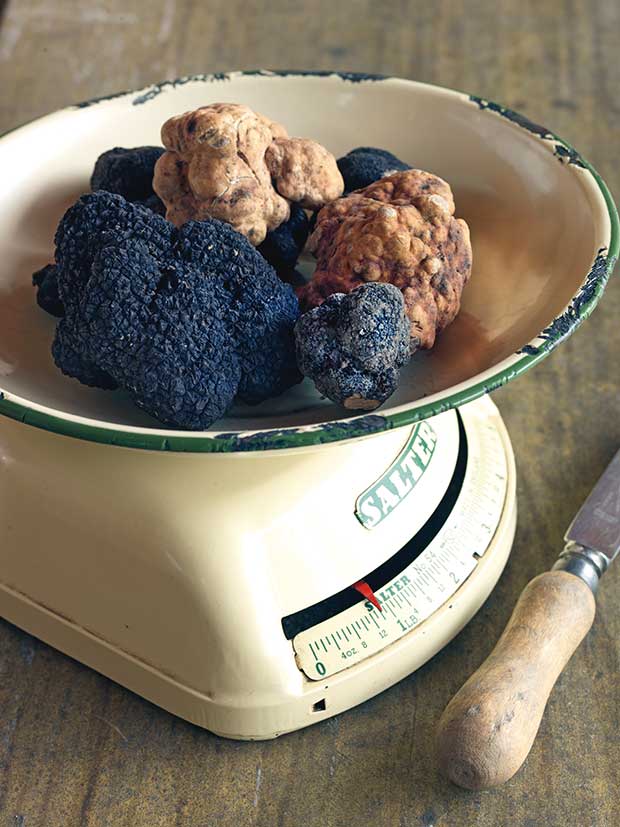
Truffles on the scales are burgundy (large black), two bianchetto (white) and brumale (small black).
Hunting for truffles is not for the impatient or the olfactorily impaired. Success calls for a sniffer-out of buried bounty – in other words, a dog.
Words: Anna Tait-Jamieson Photos: Jane Ussher
Peter Burton won’t forget the day Tracy Billingsley and her dog Ozzy found his first truffle. They had visited his property twice before with no result so on this occasion he had given up following the pair as they sniffed their way down the line of trees in his truffière.
“I’d grown bored with it and wandered off and then Tracy came to find me and – bingo!” he says with a satisfied smile. “There were two little pea-sized truffles.”
It was a modest start but it rekindled his enthusiasm for a crop that is capital intensive, extremely unreliable and all but invisible because it grows underground. Since that first find last year, Peter’s five-year-old trees have produced several more truffles, one the size of a cricket ball.
His is now one of very few producing truffières in the country and, while he takes some credit for that, he says he couldn’t have done it without the professional services of Tracy and Ozzy.
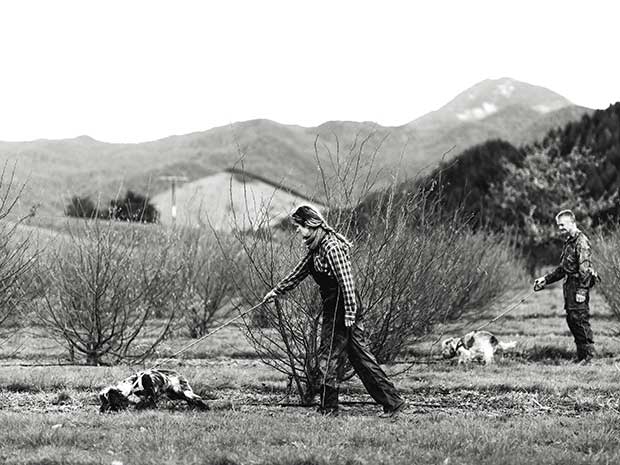
Tracy and Andy Billingsley hunt truffles with Ozzy and Pepper in the Rai Valley.
“Finding truffles is needle-in-a-haystack stuff. Without their attention to detail – their preparedness to get down on the ground and start sniffing around – it could have taken us many years to get this far.”
Peter’s Nelson property is now one of several visited fortnightly by NZ Truffle Dogs, the business owned by Tracy and her husband Andy. They launched it four years ago at a time when the country’s truffle growers were questioning the wisdom of their investments: why were they producing so few truffles? And what could they do to turn things around?
The couple had just planted their own truffière in Marlborough’s Rai Valley. They were urged on by Andy’s brother Kelvin and his partner Tania Lawrence who had ordered too many trees for their own site nearby.
The brothers, both foresters, took care of the plantings and the women, both trained chefs, joined the New Zealand Truffle Association to find out what they could about this very secretive business.
It soon became apparent that the industry’s problem was not so much a lack of truffles as a lack of dogs trained to find them. A field visit with a dog demonstration confirmed Tracy’s opinion.
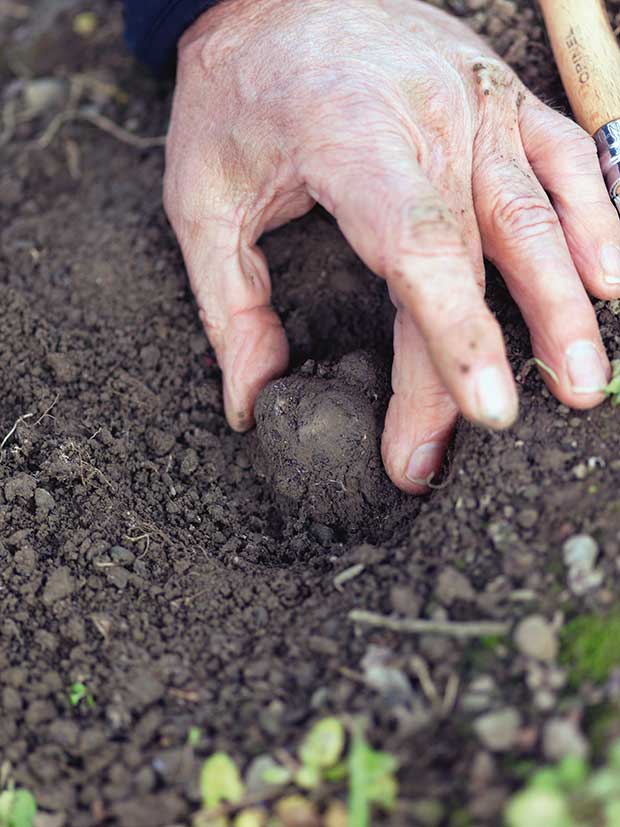
A Périgord truffle in the ground.
“We watched a few people walking around putting down baits and trying to get their dogs to hunt and I realized – because I’ve always had dogs and Andy’s had lots to do with them too – that the way these people were training them was completely wrong; there was no way those dogs were ever going to find a truffle.”
Tania describes her sister-in-law as a “give-it-a-go lady”, a true entrepreneur who identified a gap in the market and ran with it. Not quite, says Tracy, who reckons she only ever intended to train a dog to work the two Rai Valley sites.
Regardless, she put her mind to the job with admirable thoroughness.
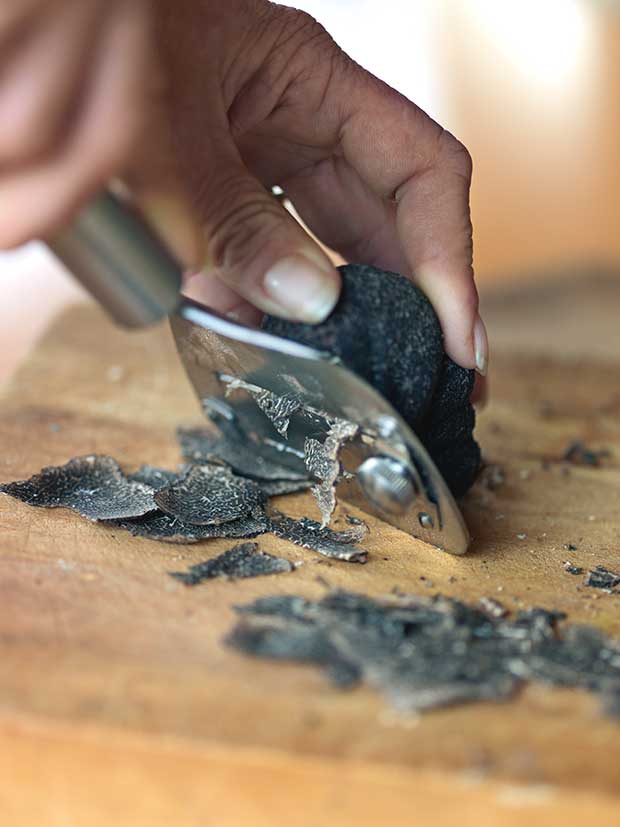
Périgord truffle shavings.
“We decided, let’s do it, let’s buy a pup and start training. So we acquired Ozzy, my number-one girl. Luckily I had connections with people who train drug and bomb dogs and I was able to take Ozzy for some training sessions with the police in Nelson which was quite entertaining because I had this little spaniel with all the really big alsatians.”
While the other dogs were taught to locate the hard stuff, Ozzy learned how to sniff out a truffle and treat it with the same caution one would a landmine.
”When the dog’s in the field you don’t want it damaging a truffle,” explains Tracy. “You want it to be passive.”
The training techniques, which she and Andy still use, are meticulous. All equipment is sterilized, no hands touch the truffle and great care is taken to ensure the dogs (there are now three) are not confused by any other scents.
They learn to seek only truffle. And because they are working dogs, not pets, their training never stops. In the off-season they practise with truffle “bait” in Tania and Kelvin’s more established truffière.
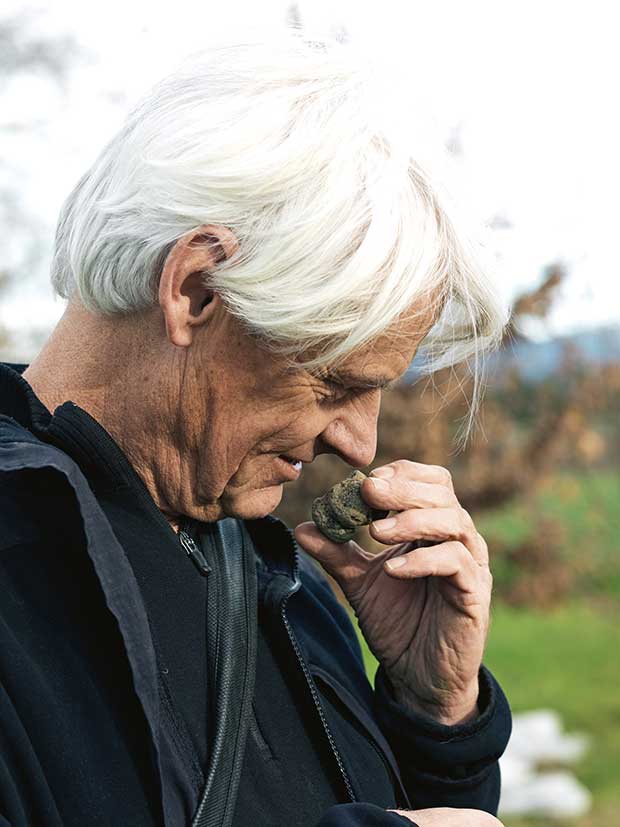
Peter Burton with a freshly dug $100 Pèrigord truffle.
The hard work has paid off. Their dogs are the best in the game. In the four years since they decided to commercialize their business, Tracy and Andy have picked up 40 clients across New Zealand, 19 of whom had never before found a truffle.
“Some of the sites are 15 or 20 years old. They tell you they’ve had dogs through over the years and there’s nothing there and then we walk in with our dogs and locate their first truffle.”
That moment is hard to beat, for two reasons. “It’s seeing the dogs happy and proud that they’ve done the job right for you and it’s the satisfaction of turning somebody into a first-time producer.
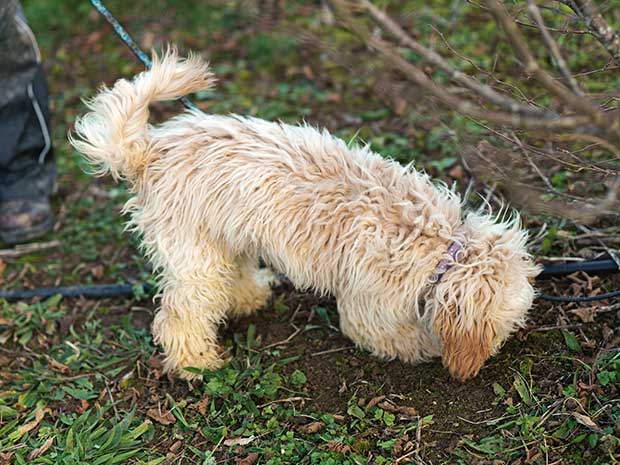
Truffle-pup-in-training Pippa thinks she’s on to something.
The smiles on their faces when they find their first truffle… you could never make that up; that’s real. It’s real happiness, real tears and real excitement.”
News of the dog team’s ability has spread through the truffle world. The demand is now such that Tracy and Andy have started breeding and training spaniel-cross pups, some of which are sold to growers who are prepared to pay up to $10,000 for a trained “nose”.
That sort of money is indicative of the potential people see in the industry but Tracy cautions against getting carried away.
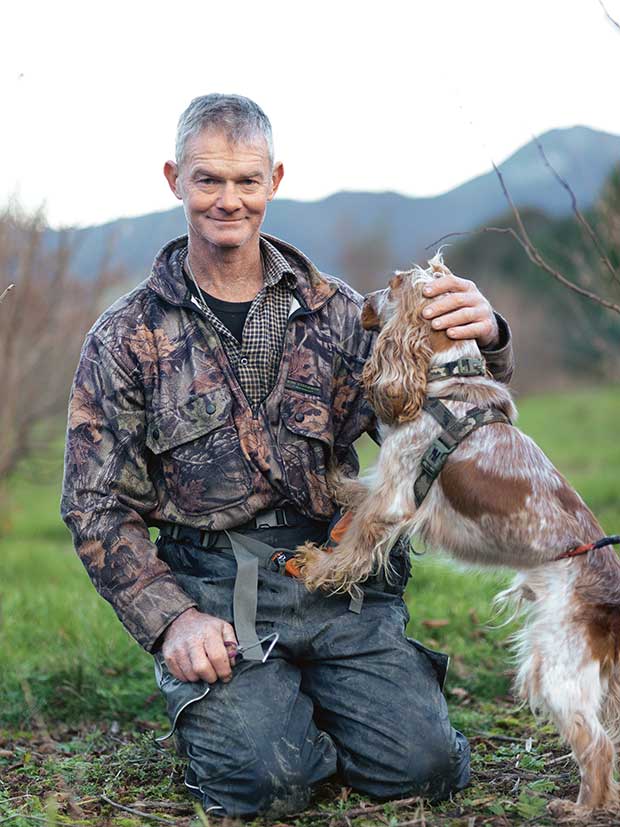
Andy Billingsley reckons truffle hunting has a lot in common with his other love, pig hunting.
As production increases, she says growers have to work to reverse the perception that New Zealand truffles are not as good as those found in Europe. That perception is mostly due to truffles being harvested before they are fully ripe but they can also be wrongly identified.
She says the gloriously scented Périgord truffle is easily confused with the almost identical but much less intense, and less valuable, brumale. “I talk to people about that all the time and I always advise them to have their truffle tested so they know what they’ve got.”
She can also put the owner in touch with a buyer. A truffle can be sold within minutes of leaving the ground and be on the table of a fine-dining restaurant the very next day, thanks to Tania who is ex-Ponsonby and has used her connections in hospitality to establish a broking business with her Auckland-based mother.
Quite a few find their way into Tania’s own kitchen. The day NZ Life & Leisure visits, her whole house is smelling of truffle.
“It’s kind of an addiction,” she admits. “I love the aroma – they smell of old socks and sex – and they’re such a rarity.
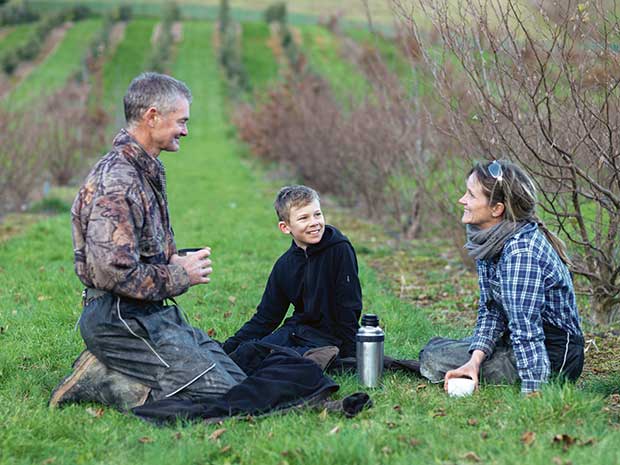
Kaine joins his parents for a break in the truffière. His job is training the pups to walk on the lead.
“You don’t need to do a lot with them; the simpler the better,” she says as she shaves truffle over the split halves of a camembert.
They’re pungent, mysterious and packed full of pheromones; the allure of a truffle is hard to explain but Tracy says she and Andy share Tania’s addiction.
“Two to three months before the season starts we almost have the DTs because we want to smell truffle again. I enjoy eating them but I absolutely love the smell: that fresh truffle in the ground with a touch of earth and a touch of rain. We are completely and utterly hooked and it’s all Tania’s fault.”
Payback for Tania and Kelvin came in April this year when the dogs found their first truffle during a training session in their field. It was an overripe burgundy and not much to crow about but, like any new find, it was the cause of much celebration.
As to Andy and Tracy’s own truffière, they’ve found nothing yet – a fact that’s hardly surprising. “We’re out there making all these other people really, really happy but we can go through a whole season without stepping on our own site.
We’ve got the dogs on the property and we haven’t even hunted the site. We’re too busy hunting everyone else’s. We could have truffle up there and not even know it.”
WHAT ARE TRUFFLES?
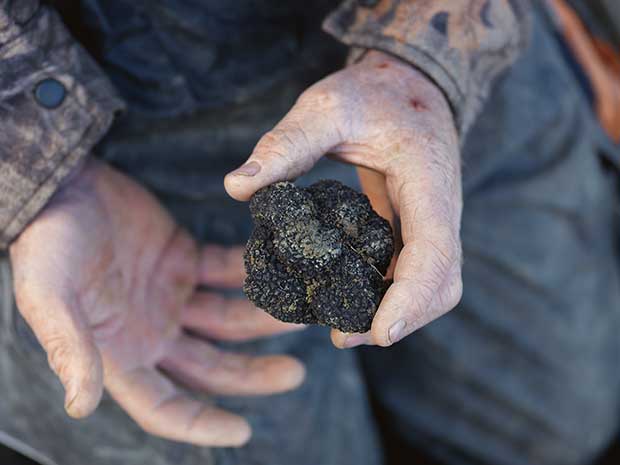
Truffles are the fruiting bodies of mycorrhizal fungi that grow on the roots of host trees.
In New Zealand they are cultivated on inoculated oak and hazelnut trees and the main variety is the Périgord or black truffle (Tuber melanosporum) which sells for up to $3500 a kilo.
Smaller quanitites of less valuable truffles are also produced: the burgundy or summer truffle (Tuber uncinatum/aestivum), the brumale (Tuber brumale) and the white bianchetto (Tuber borchii).
Of the estimated 300 truffières in the country, fewer than 40 are currently producing truffles. It’s a highly secretive business and total production is a mystery but it could be up to 300 kilos per annum. Restaurants snap up whatever is available and demand always outstrips supply.
BRUMALE: THE ROGUE TRUFFLE
When brumale was first detected in New Zealand truffières, shockwaves rippled through the industry. No one knows quite how it got onto the roots of trees that were inoculated with Périgord truffle but it was labelled an “unwanted organism” at the time because it competes for space with its much more valuable cousin.
It’s now well established in some truffières and there’s a growing acceptance that, despite its less intense, more fleeting aroma, brumale is still a good truffle.
Tracy and Andy believe that as long as it’s not confused with the look-alike Périgord truffle, there’s no reason why it shouldn’t be appreciated for its own qualities as it is in France where it commands a respectable price.
WHAT WE’VE LEARNED IN THE FIELD
Truffles grow all over the country, not just in limestone soils. We see them in volcanic soil, in sand, in clay and in river rock.
This year, based on current performance, we expect to locate about 100 kilos for our clients – about 90 percent of what’s in the ground.
It’s early days but so far the South Island seems best suited for truffles, particularly North Canterbury.
Our best find: one kilo of Périgord truffles in the same spot under one tree. Just one tap from the dog and there was $3500.
Most tragic: finding the first truffle on a site that had just been sold because the previous owner had given up on it.
WHAT I DO: The life of a truffle dog, as told to NZ Life & Leisure.
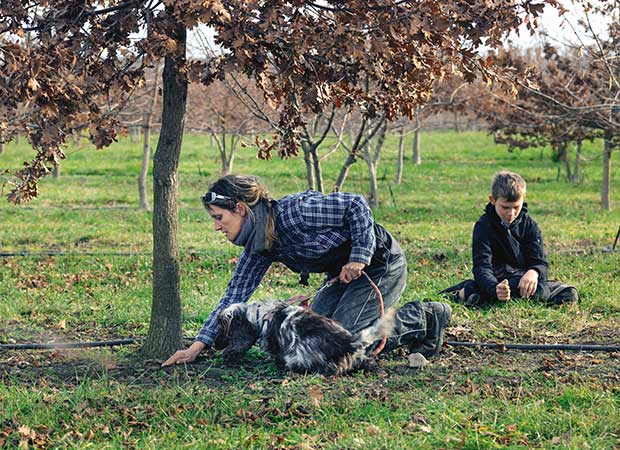
Tracy with Ozzy who finds a truffle and earns a reward.
My name is Ozzy and I’ve been doing this job for about four years now. Mostly I work with Tracy – nothing against Andy but Tracy and I… well, we’re a pretty tight team.
She takes me all over the country to sniff out truffles under people’s trees. I figure they must have forgotten where they’ve buried them but I’m not a detail dog so I leave those questions to Tracy.
I do most of my work on a lead because, let’s face it, if I got a whiff of rabbit I’d just have to go for it and you can’t let yourself be distracted in this job. It’s all sniff, sniff, sniff until you pick up the scent of truffle.
It smells fantastic and really you can’t miss it; it’s pretty damned obvious, but then people have no sense of smell, do they?
When we’ve tracked down the scent, we all have our own way of marking the spot. My mate Pepper spread-eagles herself on top of it, which looks a bit daft, but I just quietly pat the ground with my paw and look up at Tracy. She gives me a piece of cheese – I love that stuff – then she ties me to a tree while she has a good sniff herself.
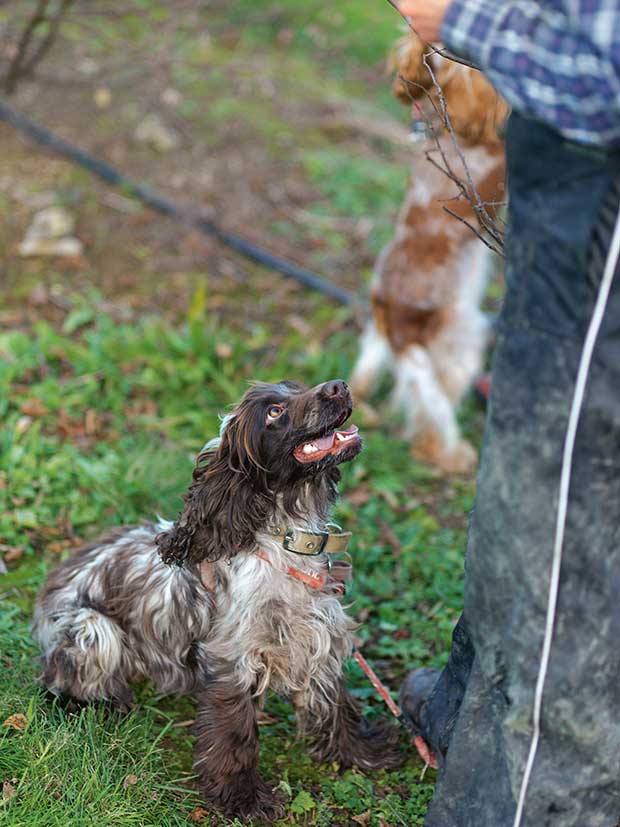
Ozzy.
And, honestly, it looks pretty funny, her pretending to act like a dog with her nose in the dirt.
I could get the truffle out of the ground in a flash myself but she likes to do this bit herself so she calls the owners over and they take ages scraping away the dirt.
When they find it they get all excited and start jumping around like they’ve found a bone or something. Sometimes they even cry about it. Not Tracy. She’s staunch.
Eventually they remember who found it and I get lots of pats and they all tell me what a good nose I have.
Sometimes they take the truffle with them and sometimes they leave it in the ground so it gets even smellier – which is a lot like a bone when you think about it – and then we move on to the next trees.
It’s a great job and we get good perks but I can honestly say I don’t do it for the cheese. I do it for Tracy. We’re a great team.
Tania Billingsley – located in the lovely RAI Valley (Marlbourgh) Tania and Kelvin Billingsley have purchased Ozzy from ex NZTruffle Dogs fame, she has worked round the country successfully finding truffle on previously non producing truffieres. We are working with Andy Billingsley to continue to breed and train truffle dogs for sale within NZ. Contact Tania on tania@mudbricklodge.co.nz or on 021 481115.
This story was first published in NZ Life & Leisure issue 51 2013
Love this story? Subscribe now!
READ MORE
Sheryn Dean experiments with growing truffles on her Waikato block
 This article first appeared in NZ Life & Leisure Magazine.
This article first appeared in NZ Life & Leisure Magazine.
